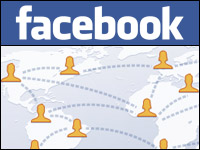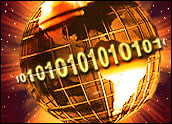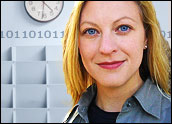
The next time you print a summary of your favorite James Bond film, you should consider that there might be more than one spy on the page. That’s because printer manufacturers and the U.S. Secret Service have been quietly collaborating to track documents — a worrisome revelation.
An announcement by the Electronic Frontier Foundation (EFF) that their staff cracked the code Xerox uses to secretly tag documents printed by color laser printers recently put the issue in the spotlight.
“At the request of the United States Secret Service, manufacturers developed mechanisms that print in an encoded form the serial number and the manufacturer’s name as indiscernible markings on color documents,” the EFF’s white paper says. But no need to take the EFF’s word for it — the secret markings can be found by anyone with a blue light and a magnifying glass.
Why the Secrets?
Law enforcement claims that the purpose of the secret markings is to help catch counterfeiters. “It’s to protect our currency and to protect people’s hard earned money,” Secret Service spokesman Eric Zahren told the Washington Post. Fighting thieves is indeed an important task, but that begs the question of why the government made such a huge policy decision behind closed doors, putting American privacy, security and freedom of speech at risk.
If an anti-theft device is to be effective, it must be useful regardless of whether anyone knows about it. The idea that secrecy is needed for efficacy is reminiscent of the encryption debates of the late 1990s when the technology community thoroughly rejected secret deals such as government-coerced back-doors into secure codes.
Government has no business dictating the design of widespread technology devices, especially when the design makes it easy for governments, or anyone else for that matter, to spy on Americans. Since anyone with common tools can view the printer’s encoding, it could put important anonymous speech at risk. One can imagine a scenario in which one person creates two documents one with that person’s name on it and the other anonymous. If another individual were to use a blue light to compare the two documents, the anonymity of the second document would disappear. That could be bad in a business setting or from an anonymous political speech point of view.
Abusing Power
What truly disturbs is the “trust us” attitude that radiates from government agencies. No one should assume that the government won’t abuse its spy powers. Recall the famously intrusive J. Edgar Hoover’s FBI which illegally wiretapped the Rev. Martin Luther King and Vietnam War protesters. But on the printer issue, the government is not solely responsible. Printer manufacturers and, apparently, banks were in on the scheme too.
One could argue that the printer companies were just doing what they needed to do in order to make sure they could sell their wares. But that’s the same sort of argument that Yahoo and others make when explaining their complicity with a rights-abusing Chinese communist dictatorship.
Consumers should reject that excuse and demand that technology producers inform customers if there are tracking devices in the products they sell, particularly when those devises are used as extensively and for so many sensitive purposes as printers. Like the cell phone cameras that captured the London bombings before government or big business got to the scene, the EFF has demonstrated that when everyone has access to technology tools, the truth comes out and has less chance of being manipulated by the powers that be.
Vendors’ Responsibility
Xerox, Canon, and other guilty printer makers should work quickly to fix this public-relations gaffe and come clean if they are aware of any other such schemes. Americans should demand that their government not operate like foreign authoritarian regimes, and make it clear that deployment of blanket spy technology is not acceptable in a country that is supposed to stand for freedom. Legislators should also pose some hard questions.
How many counterfeiters has the secret-code printer scheme actually caught? Eric Zahren of the Secret Service didn’t say. The figure is likely very low.
The time, money, and ingenuity that went into the printer-spy caper would be better spent in ways that actually catch criminals and terrorists without endangering key liberties. But perhaps the printer-spy need not be entirely scrapped. It could still be used to track waste and misconduct by government employees.
Sonia Arrison, a TechNewsWorld columnist, is director of Technology Studies at the California-based Pacific Research Institute. She also serves on the Technology Advisory Board for the Acceleration Studies Foundation.






















































You Americans are so paranoic,and so selfish, most really free societies would support gov’t measures to protect their citizens from any major threats, not winge about so called threats to their imagined "freedom of speech"
Why is everyone calling this spying or a spy caper. There is no secret here. Nearly 10 years ago I watched a TV show on the history of counterfeiting. They mentioned several times that the government works with Copier companies to A. Track attempts at counterfeiting with copiers. B. Prevent color copiers and printers from using colors that approximate colors used on US currency. It has been long known the government has been working with copier and printer companies since true colors started being used in those devices. They would not reveal the technology, but they would tell you they did it.